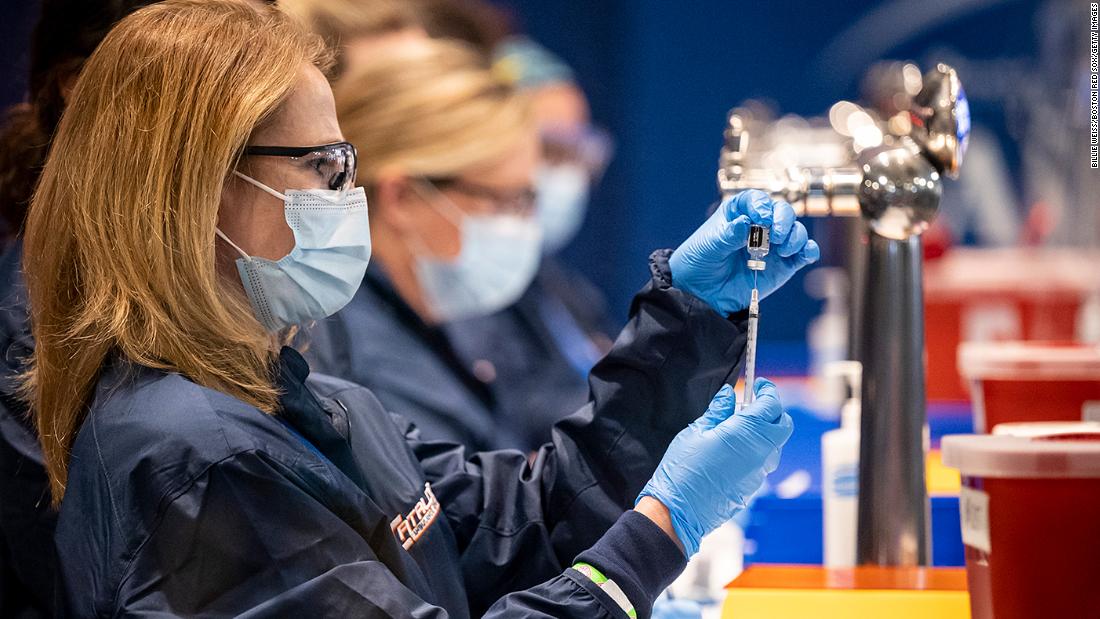
"We have a little breathing room right now, but if these new variants become dominant in our country, we are going to be right back where we were in November and December and perhaps even worse," emergency physician Dr. Megan Ranney told CNN.
Ranney's warning has been echoed by several experts recently who say while Covid-19 numbers may be trending in the right direction for now, the next few weeks could be a different story unless Americans double down on safety measures and vaccinations ramp up.
At least 32 states have found cases of a variant first identified in the UK, according to the Centers for Disease Control and Prevention. Experts have said the variant, called B.1.1.7, appears to be more transmissible.
"The surge that is likely to occur with this new variant from England is going to happen in the next six to 14 weeks and if we see that happen ... we are going to see something like we have not yet seen in this country," Dr. Michael Osterholm, director of the Center for Infectious Disease Research and Policy at the University of Minnesota, told NBC on Sunday.
But that's not all. Last week, Minnesota officials announced they had detected the first US case of the P.1 variant in a traveler from Brazil. Two states also recently detected cases of a variant first identified in South Africa, which has worried scientists because of a mutation that might make current Covid-19 vaccines less effective.
"Despite the falling numbers, now is not the time to let up on the basic precautions," Ranney warned Sunday. "Wear a mask, avoid indoor unmasked gatherings, and of course, wash your hands and try to maintain a distance from others when possible."
Expert urges change of vaccine strategy
Amid the push for more vaccinations ahead of another possible surge, Osterholm said that while it's important people get both doses of the two-part vaccines, the country needs a change of strategy to protect more Americans from what could be coming.
"We still want to get two doses in everyone, but I think right now in advance of this surge we need to get as many one doses in as many people over 65 as we possibly can to reduce serious illness and deaths that are going to occur over the next weeks ahead," he told NBC.
Getting more first doses out now should not mean giving up on a second dose, Ranney said.
"We should count on Pfizer and Moderna and hopefully soon Johnson & Johnson as well, to help fill that gap," Ranney said. "Give everyone the doses that you can right now and count on that increased production so that you can get people adequately protected."
So far, more than 25.2 million Americans have received at least the first dose of a Covid-19 vaccine, while about 5.6 million have received both doses, according to CDC data.
The problems states are facing
Across the country, allocation and distribution problems continue to slow down the pace of vaccinations.
Kentucky Gov. Andy Beshear told CNN Sunday, "if we have three problems, it's supply, supply and supply."
While the state has the capacity to give 250,000 first doses a week, Beshear said, they're only scheduled to get about 64,000 doses -- a shortfall he said other states are facing too.
"The only thing that's keeping us from defeating this virus next month, is the amount of supply we get."
Meanwhile, parts of the country are faced with a different problem: racial disparities in vaccinations.
New York City Mayor Bill de Blasio highlighted preliminary data Sunday showing a clear racial disparity among New Yorkers who have so far received vaccine doses.
"Clearly what we see is a particularly pronounced reality of many more people from White communities getting vaccinations than folks from Black and Latino communities," de Blasio said.
In response, the city expanded its list of neighborhoods that have been hardest hit by the virus and will ramp up outreach, prioritize appointments and add new vaccine sites in those areas, among other efforts, the mayor said.
The disparity, de Blasio said, needs to be "addressed aggressively and creatively."
CDC issues guidance on Super Bowl
Meanwhile, following health experts' calls to double down on safety measures, the CDC also has updated guidance on the safest ways to watch the upcoming Super Bowl.
The short version: enjoy the game with only people of your household and have other guests join in virtually.
"Attending large gatherings like the Super Bowl increases your risk of getting and spreading COVID-19," the CDC said.
For Americans who opt to attend large Super Bowl events like watch parties, the agency offered several recommendations including calling the venue ahead of time to ensure they take safety measures, follow social distancing guidelines, avoid cheering, use touchless payment methods and keep a mask on at all times.
Their full list of recommendations is here.
"time" - Google News
February 01, 2021 at 02:51PM
https://ift.tt/2NL1Qau
The US is in an 'absolute race against time' with new coronavirus variants, expert says - CNN
"time" - Google News
https://ift.tt/3f5iuuC

No comments:
Post a Comment